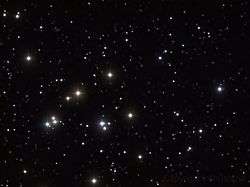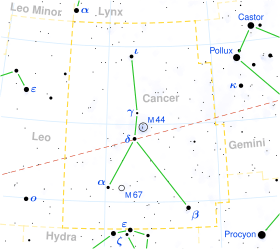Epsilon Cancri
Epsilon Cancri (ε Cancri, abbreviated Epsilon Cnc, ε Cnc) is a white-hued binary star system in the zodiac constellation of Cancer. It is the brightest member of the Beehive Cluster[12] with an apparent visual magnitude of +6.29,[2] which is near the lower limit of visibility with the naked eye. The annual parallax shift of 5.3 mas as seen from Earth yields a distance estimate of approximately 616 light-years from the Sun.
| Observation data Epoch J2000 Equinox J2000 | |
|---|---|
| Constellation | Cancer |
| Right ascension | 08h 40m 27.01052s[1] |
| Declination | 19° 32′ 41.3133″[1] |
| Apparent magnitude (V) | 6.29[2] |
| Characteristics | |
| Spectral type | A5 III[3] |
| U−B color index | +0.16[4] |
| B−V color index | +0.17[4] |
| Astrometry | |
| Radial velocity (Rv) | +29.9±1.1[5] km/s |
| Proper motion (μ) | RA: −36.301[6] mas/yr Dec.: −12.291[6] mas/yr |
| Parallax (π) | 5.2937 ± 0.0781[6] mas |
| Distance | 616 ± 9 ly (189 ± 3 pc) |
| Absolute magnitude (MV) | +0.00[2] |
| Orbit[7] | |
| Period (P) | 35.202±0.033 d |
| Eccentricity (e) | 0.32±0.04 |
| Periastron epoch (T) | 2448313.5 ± 0.7 |
| Argument of periastron (ω) (secondary) | 265±5° |
| Semi-amplitude (K1) (primary) | 53.0±1.9 km/s |
| Semi-amplitude (K2) (secondary) | 67.8±3.9 km/s |
| Details | |
| Luminosity | 83.50[2] L☉ |
| Temperature | 7,851[8] K |
| Metallicity [Fe/H] | −0.01[9] dex |
| Rotational velocity (v sin i) | 82[10] km/s |
| Age | 729[11] Myr |
| Other designations | |
| ε Cancri: Meleph, ε Cnc, 41 Cancri, BD+20° 2171, GC 11904, HD 73731, HIP 42556, HR 3429, SAO 98024, GSC 01395-02733 | |
| HD 73711: Meleph, BD+20° 2163, GC 11893, HD 73711, SAO 98018 | |
| Database references | |
| SIMBAD | ε Cancri |
| HD 73711 | |
The binary pair has the designation WDS J08405+1933. The primary star is designated Epsilon Cancri and the secondary is HD 73711. Epsilon Cancri is itself a spectroscopic binary with components designated Aa (also named Meleph[13]) and Ab. HD 73711 is itself suspected of being a spectroscopic binary.[14]
Nomenclature

ε Cancri (Latinised to Epsilon Cancri) is the system's Bayer designation (which originally referred to the entire cluster[15]).
In 2016, the IAU organized a Working Group on Star Names (WGSN)[16] to catalog and standardize proper names for stars. The WGSN decided to attribute proper names to individual stars rather than entire multiple systems.[17] It approved the name Meleph for the component Epsilon Cancri Aa on 5 September 2017 and it is now so included in the List of IAU-approved Star Names.[13]
Properties
The system is moving away from the Sun with a radial velocity of +30 km/s.[5]
Epsilon Cancri A is a double-lined spectroscopic binary system with an orbital period of 35 days and eccentricity of 0.32.[7] It has a stellar classification of A5 III,[3] which matches an A-type giant star. The spectrum displays the chemically peculiar characteristics of an Am star.[18] Its spectral type has been listed as kA3hA5mF0, indicating the different spectral types shown by spectral lines of calcium, hydrogen, and other metals.[19] The age of the system is estimated to be around 729 million years.[11]
HD 73711 is another Am star F-type star with a stellar classification of F0 III.
References
- Van Leeuwen, F. (2007). "Validation of the new Hipparcos reduction". Astronomy and Astrophysics. 474 (2): 653–664. arXiv:0708.1752. Bibcode:2007A&A...474..653V. doi:10.1051/0004-6361:20078357. Vizier catalog entry
- Anderson, E.; Francis, Ch. (2012). "XHIP: An extended hipparcos compilation". Astronomy Letters. 38 (5): 331. arXiv:1108.4971. Bibcode:2012AstL...38..331A. doi:10.1134/S1063773712050015. Vizier catalog entry
- Abt, Helmut A.; Morrell, Nidia I. (1995). "The Relation between Rotational Velocities and Spectral Peculiarities among A-Type Stars". Astrophysical Journal Supplement. 99: 135. Bibcode:1995ApJS...99..135A. doi:10.1086/192182.
- Mallama, A. (2014). "Sloan Magnitudes for the Brightest Stars". The Journal of the American Association of Variable Star Observers. 42 (2): 443. Bibcode:2014JAVSO..42..443M.Vizier catalog entry
- de Bruijne, J. H. J.; Eilers, A.-C. (October 2012), "Radial velocities for the HIPPARCOS-Gaia Hundred-Thousand-Proper-Motion project", Astronomy & Astrophysics, 546: 14, arXiv:1208.3048, Bibcode:2012A&A...546A..61D, doi:10.1051/0004-6361/201219219, A61.
- Brown, A. G. A.; et al. (Gaia collaboration) (August 2018). "Gaia Data Release 2: Summary of the contents and survey properties". Astronomy & Astrophysics. 616. A1. arXiv:1804.09365. Bibcode:2018A&A...616A...1G. doi:10.1051/0004-6361/201833051. Gaia DR2 record for this source at VizieR.
- Pourbaix, D.; et al. (2004), "SB9: The Ninth Catalogue of Spectroscopic Binary Orbits", Astronomy & Astrophysics, 424 (2): 727–732, arXiv:astro-ph/0406573, Bibcode:2004A&A...424..727P, doi:10.1051/0004-6361:20041213.
- McDonald, I.; Zijlstra, A. A.; Boyer, M. L. (2012). "Fundamental parameters and infrared excesses of Hipparcos stars". Monthly Notices of the Royal Astronomical Society. 427 (1): 343. arXiv:1208.2037. Bibcode:2012MNRAS.427..343M. doi:10.1111/j.1365-2966.2012.21873.x. Vizier catalog entry
- Gontcharov, G. A. (2012). "Dependence of kinematics on the age of stars in the solar neighborhood". Astronomy Letters. 38 (12): 771–782. arXiv:1606.08814. Bibcode:2012AstL...38..771G. doi:10.1134/S1063773712120031. Vizier catalog entry
- Hoffleit, D.; Warren, W. H. (1995). "VizieR Online Data Catalog: Bright Star Catalogue, 5th Revised Ed. (Hoffleit+, 1991)". VizieR On-line Data Catalog: V/50. Originally Published in: 1964BS....C......0H. 5050. Bibcode:1995yCat.5050....0H.
- Su, K. Y. L.; et al. (December 2006). "Debris Disk Evolution around A Stars". The Astrophysical Journal. 653 (1): 675–689. arXiv:astro-ph/0608563. Bibcode:2006ApJ...653..675S. doi:10.1086/508649.
- Wang, J. J; Chen, L; Zhao, J. H; Jiang, P. F (1995). "High-precision study of proper motions and membership of 924 stars in the central region of Praesepe". Astronomy and Astrophysics Supplement. 113: 419. Bibcode:1995A&AS..113..419W.
- "Naming Stars". IAU.org. Retrieved 16 December 2017.
- Abt, Helmut A.; Willmarth, Daryl W. (1999). "Binaries in the Praesepe and Coma Star Clusters and Their Implications for Binary Evolution". The Astrophysical Journal. 521 (2): 682. Bibcode:1999ApJ...521..682A. doi:10.1086/307569.
- Ridpath, John Clark, ed. (1897). The standard American encyclopedia of arts, sciences, history, biography, geography, statistics, and general knowledge. 6. Encyclopedia publishing co. p. 2079.
- "IAU Working Group on Star Names (WGSN)". Retrieved 22 May 2016.
- "WG Triennial Report (2015–2018) – Star Names" (PDF). p. 5. Retrieved 2018-07-14.
- Renson, P.; Manfroid, J. (May 2009), "Catalogue of Ap, HgMn and Am stars" (PDF), Astronomy and Astrophysics, 498 (3): 961–966, Bibcode:2009A&A...498..961R, doi:10.1051/0004-6361/200810788.
- Gray, R. O; Garrison, R. F (1989). "The late A-type stars – Refined MK classification, confrontation with Stromgren photometry, and the effects of rotation". Astrophysical Journal Supplement Series. 70: 623. Bibcode:1989ApJS...70..623G. doi:10.1086/191349.
